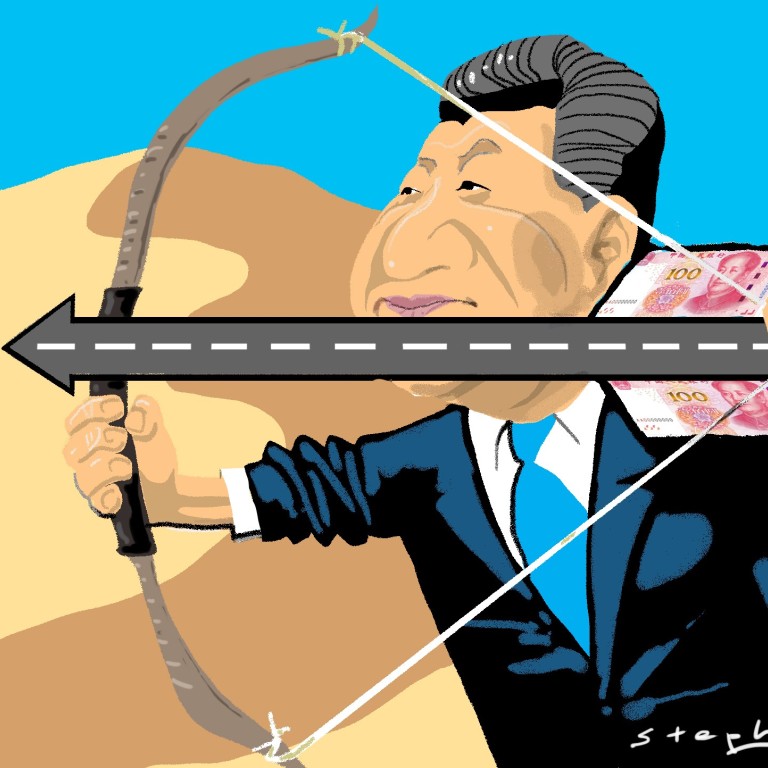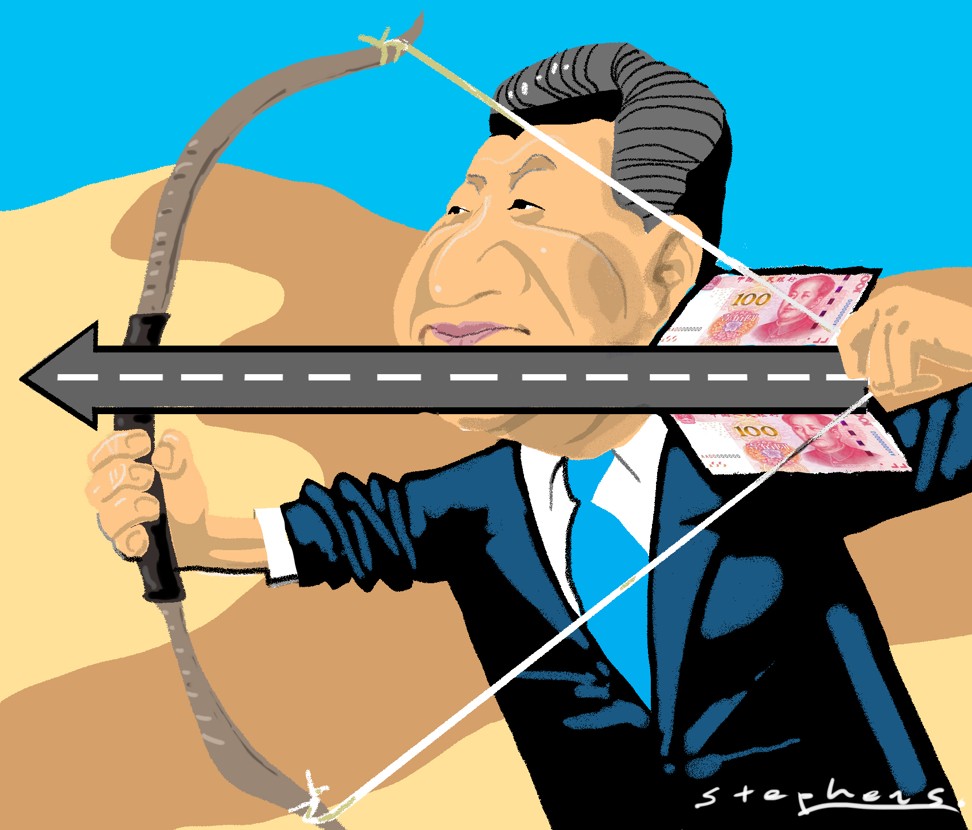
How China’s belt and road ambitions can take flight – one win-win deal at a time
G. Bin Zhao considers the areas of economic cooperation that Beijing can consider with the economically and culturally diverse belt and road countries, and the important role renminbi internationalisation can play

Economic cooperation must be the top priority at the forum. So which areas are expected to achieve breakthroughs? According to data from China’s State Information Centre, in 2016, total international trade of the 64 belt and road countries amounted to US$7.2 trillion, accounting for 21.7 per cent of global trade. China’s total international trade amounted to US$3.7 trillion, accounting for 11.2 per cent of total global trade. Obviously, in terms of economies of scale, trade volume of the belt and road countries is much higher than China’s.
Data shows that, apart from the members of the Association of Southeast Asian Nations, China’s trade volume with most belt and road economies is not commensurate with their economic scale and overall trade. For example, among the top 10 belt and road economies, Turkey (fourth), Poland (sixth) and Iran (eighth) are not among China’s top 10 trading partners. However, six Asean member countries are among the top 10 economies that have the most trade with China, showing the power of the China-Asean free trade agreement.
Therefore, signing free trade agreements may be the most effective way for China to enlarge its trade volume with the belt and road countries. Outside the 10 Asean countries, the other 54 belt and road countries have differing levels of economic development, and different trade scenarios with China. It is relatively complicated to promote free trade with them.
Lesson for China: no relationship with the Middle East can be ‘just business’

It will be hard to replicate the China-Asean free trade deal with the five major belt and road areas as these countries do not have regional cooperation mechanisms. Nations in Central Asia and Central and Eastern Europe are relatively small, while economic development levels are similar in Central Asian countries, meaning they may be ideal targets to launch collective free trade negotiations.
Another approach to promote free trade might be to target the top 10 or 20 belt and road economies outside Asean to start negotiations from “one point to the whole”.
The government work report delivered at the National People’s Congress made it clear that Beijing supports foreign investment enterprises listing on China’s stock exchanges and issuing bonds. The reality is that developed nations’ stock and bond markets are generally more mature than those of China, and if multinational enterprises choose to list in China, they may have to consider the developmental demands of China’s local markets. In addition, it may be better to support listing efforts by enterprises from belt and road nations.
At the same time, Beijing has made it clear that it supports belt and road governments and enterprises with high credit ratings as well as financial institutions issuing yuan-denominated bonds in China. Such matters are expected to be handled quickly after the summit.
Our data shows that, among all stock exchanges in the belt and road countries, none can compare with those in Shanghai, Hong Kong and Shenzhen in terms of total market value. If the scale of economies is taken into account, Singapore and India have a comparative advantage. The gap between belt and road countries’ bond markets and China’s is even greater.
Development of the belt and road and renminbi internationalisation will be a long and slow process
Second, the renminbi capital that belt and road enterprises would gain from China’s stock and bond markets could not only be used in trade, investment and commercial activities with Chinese enterprises, but could also circulate within the belt and road or other regions. This would greatly promote economic cooperation while enhancing renminbi internationalisation and providing more investment opportunities for residents and businesses in the country.
Development of the belt and road and renminbi internationalisation will be a long and slow process. They are the key drivers of China’s future economic development and deeper integration with the world.
If China’s economic globalisation is an arrow shot from a bow, then the belt and road is an important circle on the bull’s eye, while renminbi internationalisation is like the delicate feathers on the arrows, making them more powerful and accurate.
Beijing’s plan to internationalise the yuan remains on track

For example, oil and gas trade between China and Russia is settled in renminbi. China, as the world’s largest importer of energy and minerals, can take advantage of this to promote renminbi pricing and settlement with other belt and road economies in energy and mineral trade. More specifically, oil products are the No 1 trading products for the belt and road countries.
It must be remembered that economic interests were the core drivers of the ancient Silk Road. Without these, the New Silk Road could be consigned to history
There are other advantages in promoting renminbi internationalisation in major belt and road economies, rather than in developed nations, and progress is more likely. At the same time, it also accords with the overall renminbi development process of regional first, then international.
In 2016, overseas investment by Chinese companies entered a new era. According to data from PwC, mainland Chinese enterprises’ overseas mergers and acquisitions totalled US$221 billion, an increase of 246 per cent over 2015.
Meanwhile, in 2016, as the Chinese currency continued to fall against the US dollar, foreign exchange controls were tightened and foreign investment approvals slowed, which has seriously affected the willingness of enterprises to expand overseas. In this context, China’s investment in the belt and road countries also increased, but compared with developed markets, it (except Singapore) is still “non-mainstream”.
When Chinese enterprises invest abroad, their decisions are usually more market-oriented. Since the majority have a low level of internationalisation and a limited knowledge of overseas markets, developed countries are often preferred, and most belt and road economies are usually a second option due to the high risk, small market and uncertainties for return on investment.
Therefore, domestic policy support is vital to encourage Chinese companies investing in the belt and road countries. Of course, such preferential policies must be based on market-oriented commercial activities.
Crucial to success of China’s ‘One Belt’ plan? A little reciprocity, say experts
Finally, it must be remembered that economic interests were the core drivers of the ancient Silk Road. Without these, the New Silk Road could be consigned to history. Therefore, no matter how beautifully this new vision is described, economic cooperation will always be its backbone. One of Beijing’s “four principles” for the belt and road is to abide by market rules and international norms, allow the market to play a decisive role in resource allocation, and allow governments to perform their due functions. Only by doing so will development of the Belt and Road Initiative be sustained over the long term.
G. Bin Zhao is senior economist at PricewaterhouseCoopers China. The opinions expressed here are the author’s own

